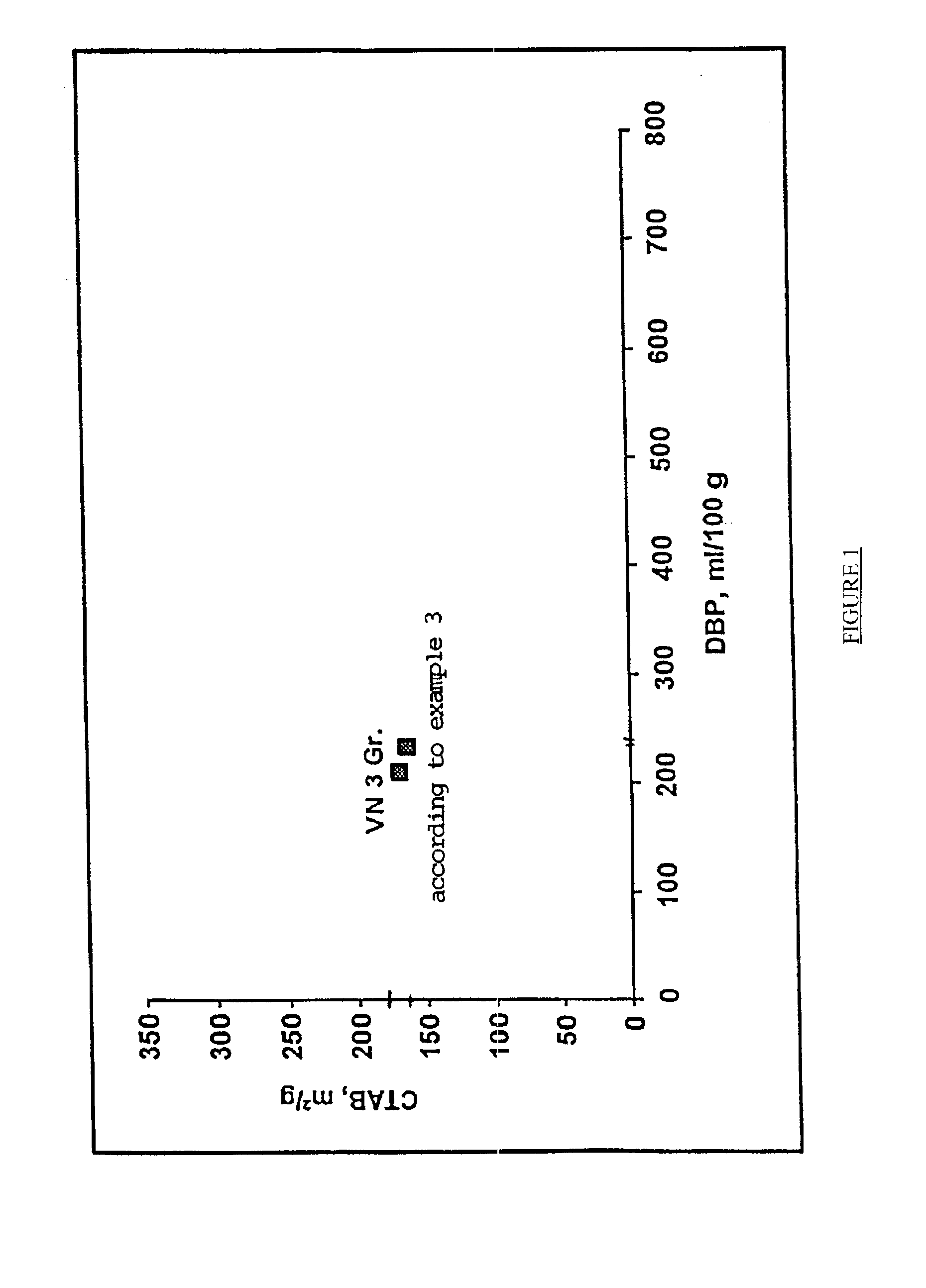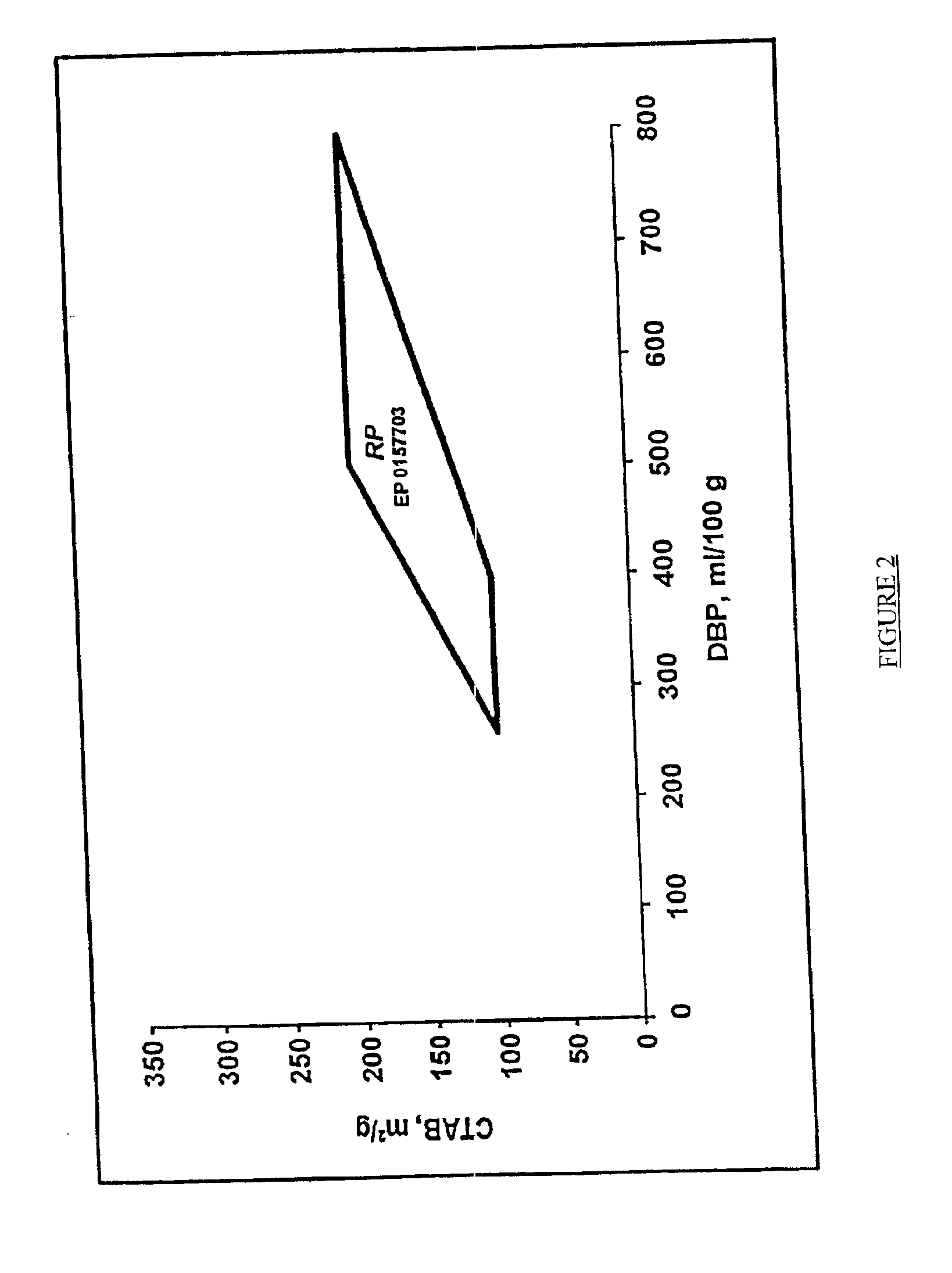Precipitated silicas
a technology of precipitated silicas and silicas, which is applied in the field of precipitated silicas, can solve the problems of poor dispersion, poor dispersion, and poor dispersion of known silicas in rubber compounds, and achieve the effects of improving dispersion properties, improving dispersion properties, and constant surface area
- Summary
- Abstract
- Description
- Claims
- Application Information
AI Technical Summary
Benefits of technology
Problems solved by technology
Method used
Image
Examples
example 1
Production of a Silica According to the Invention with an N2 Surface Area in the Range 100 m2 / g
[0041]43.5 m3 of hot water is introduced into a vat and customary commercial sodium waterglass (weight modulus 3.42, density 1.348) is stirred in a quantity such that a pH of 8.5 is achieved. While maintaining a precipitation temperature of 88° C. and pH 8.5, 16, 8 m3 of the same water glass and sulfuric acid (96%) are simultaneously added within 150 minutes from opposite positions. A solids content of 100 g / l is produced. Further sulfuric acid is then added until a pH of <5 is achieved. The solids are separated in presses, washed and the pressed paste dried by spray drying or in a rotary kiln and optionally ground.
[0042]The precipitated silica obtained has an N2 surface area of 80 m2 / g, an aggregate size of 1320 nm and grindability of 10 μm. The Sears value (V2) is 9.0 ml / (5g) and Hg porosimetry 2.7 ml / g. The CTAB surface area is 75 m2 / g. The DBP value is 236 ml / 100 g. The V2 / V1 ratio is ...
example 2
Production of a Silica According to the Invention with an N2 Surface Area of the 100-150 m2 / g Range
[0043]The same procedure is used as in Example 1, with the exception that a pH value of 9.0 is maintained in the initial precipitation batch and during precipitation. After 135 minutes, a solids content of 98 g / l is achieved in the precipitation suspension.
[0044]The precipitated silica obtained has an N2 surface area of 120 m2 / g, grindability of 8.8 μm, a Sears value of 9.1 ml / (5g) at an aggregate size of 490 nm and an Hg pore volume of 2.85 ml / g. The DBP value is 270 ml / 100 g. The CTAB surface area is 115 m2 / g. The DBP / CTAB ratio is 2.34.
example 3
Production of a Silica According to the Invention with an N2 Surface Area in the 150-200 m2 / g Range
[0045]The same procedure is used as in Example 2, with the difference that the precipitation time is shortened to 76 minutes and the precipitation temperature reduced to 80° C. After this period, a solids content in the precipitation suspension of 100 g / l is achieved. The precipitated silica obtained has the following physicochemical parameters:
[0046]
BET surface area 184 m2 / ggrindability of 8.7 μmSears value15.7 ml / (5 g)
at an aggregate size of 381 nm, Hg pore volume 2.26 ml / g. The CTAB surface area is 165 m2 / g. The DBP value is 255 ml / 100 g. The V2V1 ratio is 0.2080 to 0.2299. The DBP / CTAB ratio is 1.545.
PUM
| Property | Measurement | Unit |
|---|---|---|
| particle size | aaaaa | aaaaa |
| particle size | aaaaa | aaaaa |
| concentration | aaaaa | aaaaa |
Abstract
Description
Claims
Application Information
 Login to view more
Login to view more - R&D Engineer
- R&D Manager
- IP Professional
- Industry Leading Data Capabilities
- Powerful AI technology
- Patent DNA Extraction
Browse by: Latest US Patents, China's latest patents, Technical Efficacy Thesaurus, Application Domain, Technology Topic.
© 2024 PatSnap. All rights reserved.Legal|Privacy policy|Modern Slavery Act Transparency Statement|Sitemap



